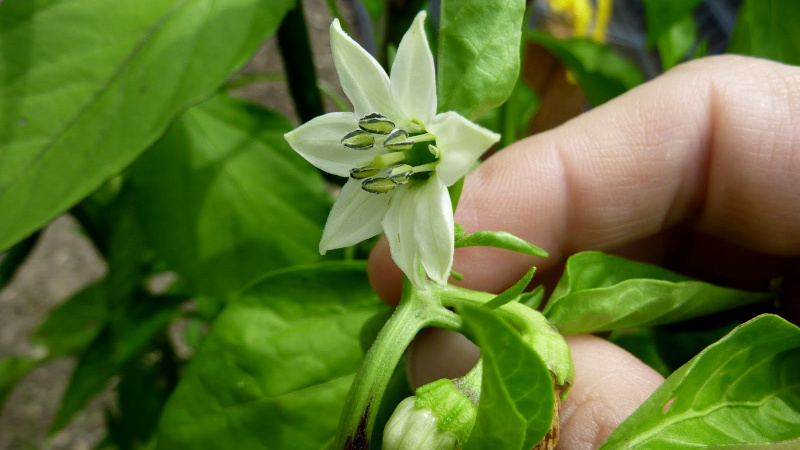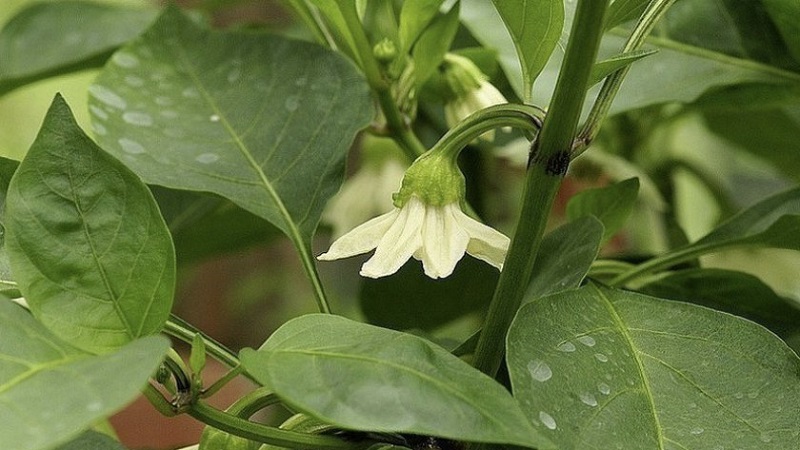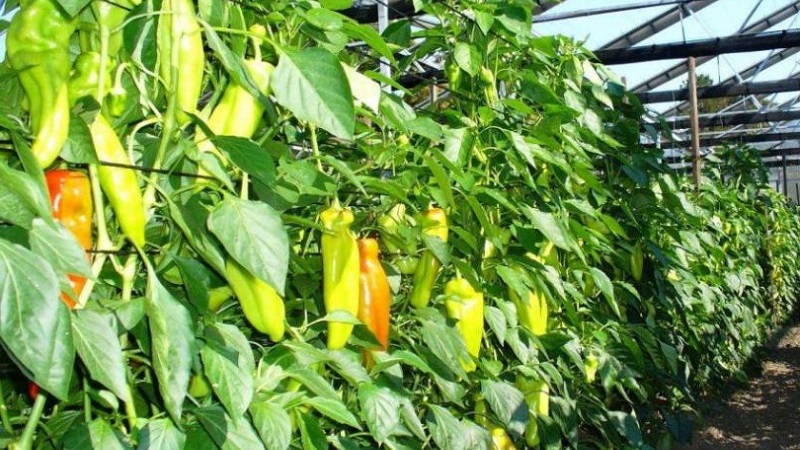Why peppers are not tied in the greenhouse: what to do to get a rich harvest
Some gardeners are faced with such a problem: after planting, the pepper grows and develops well, even blooms, but alas, it does not bear fruit. The reason is the absence of ovaries on the bushes.
From the article you will learn why barren flowers appear and how to fix the problem quickly and efficiently.
The content of the article
Why peppers in the greenhouse are not tied
Indoors, situations often arise when peppers do not form flowers, and even if they bloom, they do not set fruits.
To save the harvest, you need to understand the reasons. Many factors affect the formation of barren flowers - the absence of potassium and boron, low and high temperatures, mistakes in agricultural technology. These reasons need to be found out and eliminated.

Plants bloom, but there are no ovaries and no fruits
If the pepper grown in the greenhouse blooms on time and profusely, but without the formation of an ovary, then the main reason is the sterility of the pollen.
Why there is a problem with the formation of ovaries:
- significant temperature differences during the day and night;
- the greenhouse is not ventilated due to rainy or cold weather;
- low light level, short daylight hours;
- lack of potassium and boron in the soil of the greenhouse - with a shortage of these elements, the ovary does not form or immediately falls off;
- excessively humid air of the greenhouse makes the pollen moist and heavy - in this state it cannot spread through the flowers;
- too warm air in the greenhouse, above 28 ° C, leads to absolute sterility of pollen;
- lack of insects that pollinate flowers.
Possible reasons
Pepper bloom will not occur if an excessive amount of fertilizer with a high nitrogen content has been applied to the soil. The use of manure is not recommended - pepper reacts poorly to it.
If the culture sheds ovaries during flowering, this may be due to night frosts. Watering with cold water provokes disease culture.
For these and other reasons - in detail.
Too high or low temperature
Pepper belongs to heat-loving crops. From the moment the seedlings appear and throughout the entire period of growing the bush, it is recommended to maintain the temperature within 23-28 ° C. A significant deviation from this temperature regime will negatively affect all stages of the growing season of pepper, including the fruiting period. If at night the temperature drops below 15 ° C, the soil cools down, the root system of the plant stops working. This leads to a stop in feeding, flowers and ovaries fall off, fruits are not formed.
If an ovary appears on the bushes, which dries slowly, without having time to form a fruit, this is the result of the influence of cold air. In greenhouse conditions, this problem is eliminated by watering the soil overnight with warm water. The heated earth will give off heat until morning. For the same purpose, containers with warm water are installed in greenhouses at night. As it evaporates, water gradually heats up the air.
When the temperature rises above 30 ° C on hot days, the pepper begins to shed buds, flowers, stalks, ovary. This problem is eliminated by regular watering and irrigation of the pepper bushes.
Attention! The shedding of flowers and ovaries also occurs when there is a sharp difference in day and night air temperatures.
Errors in site selection

The choice of the site on which the greenhouse will be installed is of great importance for the correct cultivation of pepper and the receipt of the harvest. The ground under the greenhouse should not be dense, heavy, or acidic.
Close groundwater is not allowed. The presence of a nearby reservoir also contributes to the constant waterlogging of the soil. Pepper loves moisture, but in moderation. An excess of moisture has a bad effect on the development of the plant: its growth is inhibited, buds and ovaries are not formed.
With stagnant water, the root system is poorly supplied with oxygen. This affects the green mass of the bush: the leaves turn pale, turn yellow and fall off. The bush remains without buds and flowers. Bushes can develop root rot or other diseases that occur when grown in unfavorable conditions. It is extremely difficult to solve this problem when it occurs - it is better to choose in advance a suitable place for installing the greenhouse.
Great importance is attached to the illumination of the site. The greenhouse is not installed in the shade of tall trees, on the shady side of the house. In a darkened area, culture will not grow.
The greenhouse is placed in well-lit areas, preferably in an area with a southern slope. With a slight slope, uniform illumination of all bushes is achieved. Daylight hours should be at least 12 hours. Any deviation from the norm of illumination leads to dropping of flowers and ovary. Therefore, in prolonged cloudy weather, plants need additional lighting.
Lack of nutrients
Insufficient soil fertility leads to defective plant development. Before growing pepper, the soil in the greenhouse is enriched with organic fertilizers, wood ash, biohumus. At the initial stage of the growing season, nitrogen and phosphorus fertilizers are applied to the soil. Can feed seedlings with Ammophos solution.
Before flowering, the soil is saturated with potash and phosphorus fertilizers. Lack of phosphorus and potassium results in little or no flowering. In the absence of phosphorus fertilizers, plants gradually shed flowers and ovaries. This problem will be eliminated by the introduction of complex dressings - spraying with the preparations "Ideal", "Surprise", "Impulse +".
Attention! Pepper dressing spend in the morning hours. The process of pollination and ovary formation occurs during the day. Evening feeding will not bring results, since the plants rest at night, and all processes are suspended.
Before laying the buds, fertilizing with nitrogen fertilizers is stopped. Saturation of the soil with nitrogen contributes to the active growth of green mass, but not flowers and fruits.
Organic fertilizing is used with caution - bird droppings, cow dung, humus.
Unrealized pollination

The pepper forms ovaries only after cross-pollination of the flowers.
If there is a significant drop in temperature at night, no pollen is formed and pollination becomes impossible.
If on hot, dry days the air temperature rises to 30 ° C and higher, this leads to complete sterility of the pollen.
The pollination process involves transferring pollen from the stamens to the pistil. To do this, it must be light and volatile. At the beginning of the flowering of pepper, irrigation is carried out carefully, as wet pollen loses its properties, becoming heavy. In this state, it becomes impossible to transfer it from one flower to another. The flower's anther should develop in a dry, warm state.
Insects play an important role in pollination. To attract them to the greenhouse, plant leaves are sprayed with sweet syrup, and honey plants are planted in the aisles.
Pollination can be stimulated with the help of "Bud", "Ovary" preparations. Flowering bushes are sprayed with stimulating drugs in the morning. However, fruits obtained in this way differ in taste and appearance from fruits grown as a result of natural pollination.
Council. Get new full-fledged ovaries after removing barren flowers.
What to do
To eliminate the causes of the appearance of barren flowers and achieve full fruiting, you must follow the growing rules:
- observe the irrigation regime to prevent drying out and waterlogging of the soil;
- pour water at room temperature;
- when carrying out dressings, choose complex fertilizers with a low nitrogen content, boron should be included in the fertilizer;
- if necessary, additionally illuminate the greenhouse room;
- regularly ventilate the greenhouse - the air flow facilitates the movement of pollen.
- timely humidify the air in hot weather;
- if possible, adjust the temperature regime - during nighttime cold snap, put containers with warm water;
- pinch the tops during the growing season - the more side shoots there are, the more ovaries will appear;
- timely tear off flowers on which the ovary has not formed;
- carry out artificial pollination - gently shake the bushes, apply fans, transfer pollen with a brush from one flower to neighboring ones;
- observe agricultural cultivation techniques - watering, loosening, crop rotation.
If the pollination process was successful, it will be noticeable by the flower after 3-4 days. The petals of a pollinated flower deviate backward.
How to prevent problems

For the timely fruiting of pepper, preventive measures are taken in advance. They choose the right place to install the greenhouse, think over the methods of ventilation, lighting, heating and irrigation.
High-quality seeds are used for sowing. Before planting, they are disinfected, warmed up, processed in growth stimulants. Planting seedlings on time, without overdoing it and not allowing flowering in pots.
Bushes are planted in pairs, at a short distance from each other. This is necessary for cross-pollination.
Before flowering, fertilizers are applied with potassium, boron, phosphorus and fertilizing with nitrogen is limited.
Useful Tips
Experienced gardeners use special techniques when growing peppers:
- In the northern regions, in August, they begin to cover the beds with pepper with light agrofibre. This allows you to accumulate heat during the day, and give it to plants at night.
- They make beds from west to east for better illumination of the bushes so that they do not create shadows for each other.
- Before the formation of the ovary, immunomodulators "Epin extra", "Zircon" are used to prepare the culture for possible adverse weather conditions.
- Ovaries are sprayed with a composition of yeast and water. It is a good feeding and fruit growth stimulator.
- The fruits are cut off as soon as they reach the stage of technical maturity - they acquire the color corresponding to the variety. This serves as an impetus for the formation of new ovaries.
Conclusion
Pepper is considered a demanding crop. It takes a lot of effort to get the harvest. Observing the recommended agrotechnical standards of temperature, humidity, watering and carrying out pollination measures, you can achieve abundant ovary and amicable ripening of fruits.